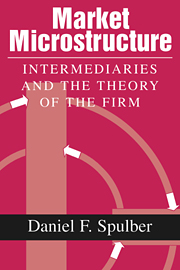Book contents
- Frontmatter
- Contents
- Preface and acknowledgments
- Introduction
- Part I Market microstructure and the intermediation theory of the firm
- Part II Competition and market equilibrium
- 3 Competition between intermediaries
- 4 Intermediation and general equilibrium
- Part III Intermediation versus decentralized trade
- Part IV Intermediation under asymmetric information
- Part V Intermediation and transaction-cost theory
- Part VI Intermediation and agency theory
- Conclusion
- References
- Index
3 - Competition between intermediaries
Published online by Cambridge University Press: 18 December 2009
- Frontmatter
- Contents
- Preface and acknowledgments
- Introduction
- Part I Market microstructure and the intermediation theory of the firm
- Part II Competition and market equilibrium
- 3 Competition between intermediaries
- 4 Intermediation and general equilibrium
- Part III Intermediation versus decentralized trade
- Part IV Intermediation under asymmetric information
- Part V Intermediation and transaction-cost theory
- Part VI Intermediation and agency theory
- Conclusion
- References
- Index
Summary
Industrial organization presents a theory of the firm based on two key elements that represent significant differences with the neoclassical firm: market power and competitive strategy. The firm in industrial organization exercises its market power by being a price maker rather than a price taker, selecting prices for its products and services. Moreover, the firm in industrial organization formulates a competitive strategy in anticipation of, or in reaction to, the strategic actions of rival firms.
The presence of market power has several important ramifications for the theory of the firm. First, the focus of attention shifts from technology to market demand. The firm continues to act as a producer as in the neoclassical framework. Its production activities are presumed to be efficient and are represented by a cost function. In addition to its cost function, the firm is described in terms of its market demand, which reflects the willingness to pay of the firm's actual and potential customers. Therefore the industrial-organization model represents the firm by its demand and cost functions.
The firm with market power is concerned primarily with how to set profit-maximizing prices. As a price setter, the firm provides the mechanism by which markets clear. The firm changes prices to reflect exogenous shifts in demand and to balance sales with production and inventories. The firm in industrial organization does not have a supply function in the neoclassical sense, although the firm may choose to offer a schedule of prices and quantities to prospective buyers.
- Type
- Chapter
- Information
- Market MicrostructureIntermediaries and the Theory of the Firm, pp. 61 - 80Publisher: Cambridge University PressPrint publication year: 1999



